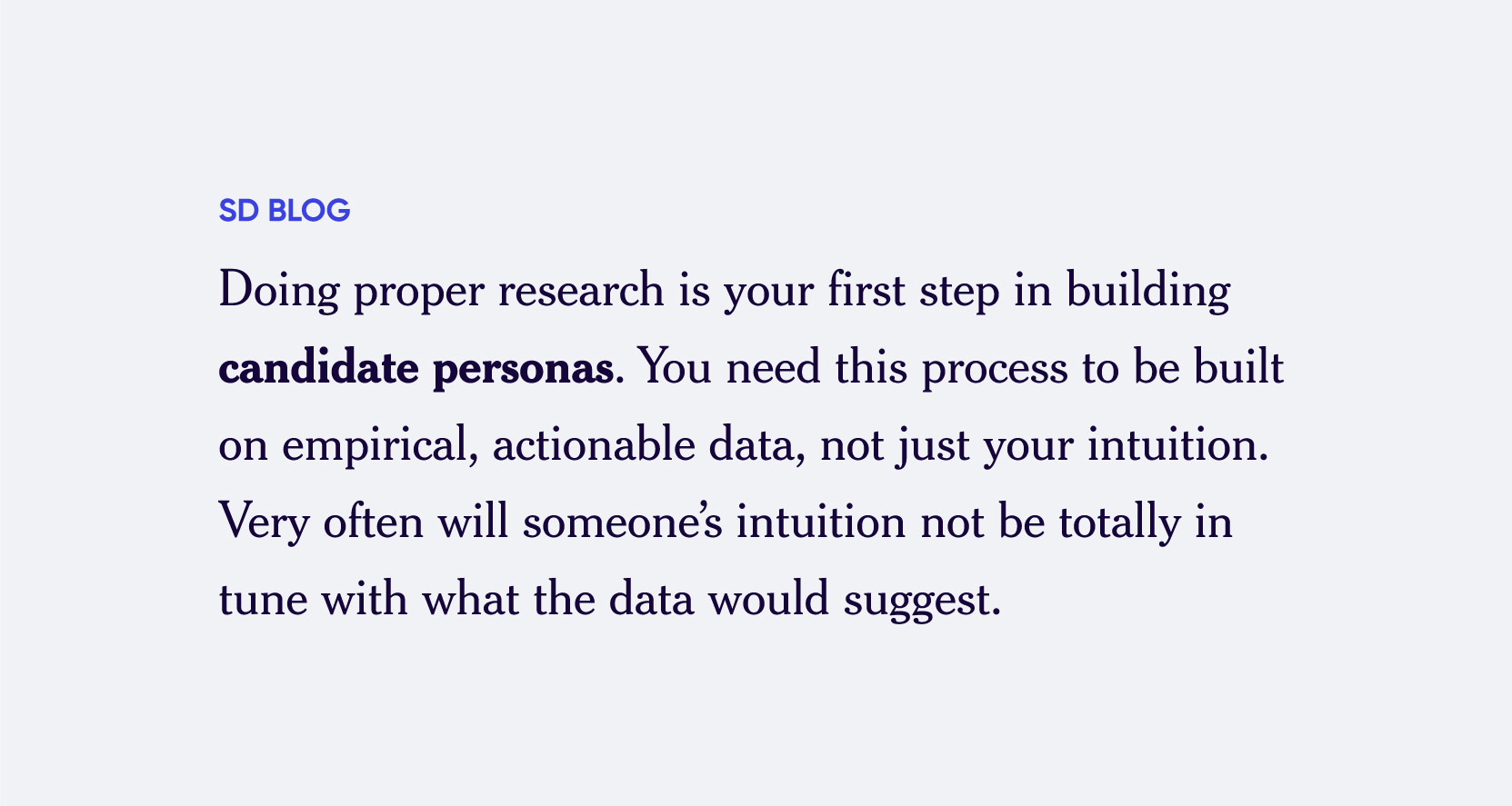Recruitment is a central part of almost any business. Are you doing everything you can to ensure that you’re hiring the best possible applicants to work for you? In marketing, one of the most commonly used tools is the “buyer persona”: an archetype of a business’s perfect customer, what they look like, and how to approach and attract them as a business. The persona tool can be used outside of just marketing, however. Talent Acquisition is one of the best areas to make use of personas, where recruiters build their ideal candidate for a specific role. Building candidate personas is crucial to having a strong TA strategy. So, here are some of the most important steps of building candidate personas for your recruiters to work with.
Gathering Data
Doing proper research is your first step in building candidate personas. You need this process to be built on empirical, actionable data, not just your intuition. Very often will someone’s intuition not be totally in tune with what the data would suggest. But, you also don’t want to only rely on data, because on its own, data is just numbers. You can use data to confirm, deny, or supplement things you have imagined with your intuition. You can also use data to come up with new ideas, new approaches which you would never have thought of on your own.
Just like with buyer personas, there will be many candidate personas for your business. Depending on the role, your candidate person will change. When building your character personas, you should always ask yourself whether your personas cover the wide range of positions you’d like to fill in your business. If not, then you should try your best to fill those gaps with more personas. The closer you are to assigning a persona to each major position in your company, the better off you’ll be when it comes to recruitment and hiring down the line.
When creating buyer personas, the first thing marketers look at is the data they already have on hand: what sort of customers they have been working with this whole time, before trying to build a buyer persona. The same can be done for recruiters. Looking at what kind of candidates, hires, and placements your business has had (both successful and unsuccessful) is a great place to start. Your business already has so much data ready and waiting for you to take advantage of. So how do you make use of it?
The first step is to conduct interviews with your current employees, especially your most successful and best-performing ones. Doing a simple interview with them will help you figure out more concretely what you are looking for. You can use your current best employees as the first building block for your candidate personas.
You can go beyond the limits of your own business (especially if you’re small and don’t have that many employees) and go interview successful employees that work outside of your company. This can be more difficult to achieve because interviewing people who already have jobs isn’t the most practical thing to do. A great way to get around this is to contact experienced recruiters and hiring managers from other businesses and discuss candidate personas with them. This isn’t exactly “data”, but it will help you orient yourself within the hiring landscape.
Here are some of the most important data points to consider when gathering information for your candidate personas:
- Basic demographics: age, location, income bracket, employment status.
- Background information: education (degrees, area of education, specialization), employment history, experience.
- Personal qualities: things like generic strengths and weaknesses, interests, hobbies, things they dislike, etc.
- Skills: courses completed, certifications, and other skills.
- Goals: a candidate’s outlook on the future, and career aspirations.
- Dealbreakers: Think about all areas, like your company’s brand, culture, vision, and mission, but also location, salary, workplace, and infrastructure, that a candidate would say no to.
- Online activity: figure out where your candidates spend their time online. Which social media platforms do they use the most, and what kind of websites do they consult regularly.
The great thing about these data points is that they are easily accessible either through your candidates or through recruiting databases, so the data is at your fingertips. However, you shouldn’t be content with only these data points. Each business is different, and you should ensure that you’re not missing out on any data points that would be crucial for building candidate personas for your business.
The last way to gather useful data for your candidate personas has to be done during the recruitment process. It is extremely important to ask candidates what they think is interesting to them about your company (for successful candidates) or what made them choose to not move forward with the hiring process (for unsuccessful candidates).
Since your company is building candidate personas, there will always be a bias within how they are built. Getting feedback from candidates themselves allows you to soften some of the bias presents within your candidate personas. Candidates are a great source of information that exists outside of your company and will have a much smaller bias.
Additionally, regularly getting feedback from candidates is the best way to enable small tweaks to be made with your current candidate personas, always keeping them up to date. Remember that building a candidate persona is always a work in progress, so you’re never done building it, even if you think you are.
Spotting trends
Once you’ve gathered your data, it’s time to start digging into it to identify the trends buried underneath all those numbers. This is when you’ll start moving from random data points to something that resembles a candidate persona.
Taking the previously mentioned data points as an example, here are the questions you should be asking when looking at your data to start identifying trends:
- Basic demographics: what basic qualities do the best candidates have in common? Are they typically of a certain age?
- Background information: what level of expertise in general (education and professional experience) did your ideal candidates demonstrate?
- Personal qualities: which strengths were emphasized by the best candidates, and which weaknesses were the least problematic?
- Skills: what level of qualification and certification are you looking for in a candidate?
- Goals: what trends are there in your favorite candidates’ goals? How closely do they align with your company as a whole?
- Dealbreakers: how did your company fall short when it came to top candidates?
- Online activity: which online platforms are candidates active on, and are these platforms places where you can potentially reach out to them?
When spotting trends, it’s important to try to stay as objective as possible. Quite often, trends in top candidates will not align with your own preferences and might not even sound very satisfying to you as an employer. For instance, you might have very long-term goals of growth, and you seek to build a strong family with your employees. For one specific position, however, you may find that your candidate person is someone who is generally focused on short-term growth and is likely not seeking to stay with you in the long term. This kind of realization can be hard to handle, but the trends rarely lie, so it’s best to not dismiss what your data tells you just because it’s not exactly what you were hoping for.
This is obviously easier said than done, so what is the solution? How can you ensure that you are not injecting too much of your personal bias into your candidate personas and ensure that you’re building the most valuable personas for your business?
You can hire a third party to assist you in identifying trends, but this isn’t always the best choice. A third party is just another set of humans, which will come with their own biases. Outside biases may be more dangerous for your business than your own, so it’s a risky proposition.
A better solution is to use software to analyze your data for you. Data processing solutions are not only much more powerful than humans when it comes to processing data, they are also much more accurate and reliable. As long as you’re giving a computer structured data to analyze, it’s going to hand you a much more objective analysis of that data than any human ever could. Automating the trend identification process can be extremely beneficial to you in creating accurate candidate personas.
Assembling personas
Now that you’ve gathered your data and identified the key trends within it, it’s time to start assembling your candidate personas. You’ll be using all the information you’ve gathered to create a hypothetical candidate for a specific position in your company.
At this stage, your priority is to build the archetype of your ideal candidate. An archetype is an imaginary person who has certain specific characteristics. The archetype happens to have the perfect characteristics in every area for your company. This means that your candidate persona may not even reflect someone who exists out there, in the real world. The point of creating a candidate person isn’t to reject anyone who doesn’t perfectly align with it: if you do that, you’ll have a very hard time hiring new employees! The point is to have something to compare your candidates to and to do your very best to find the candidate that most closely matches their related candidate persona. For instance, your candidate persona may have a graduate degree, but you could very easily end up hiring someone with only an undergraduate degree because outside of that they were the closest candidate to the persona you built.
A great way to make sure that you’re not dismissing candidates that are close enough to your candidate persona is to use software to process your applications. With enough data, you can easily let a program evaluate how closely applicants resemble your candidate persona, and you can even give them a score to help streamline the hiring process.
Try SmartDreamers
SmartDreamers is a platform that is built to assist you in all things recruitment. When it comes to building candidate personas, SmartDreamers offers many tools to assist in gathering, processing, and analyzing data from your candidates, helping you build the most accurate and valuable persona candidates for your company. Request a demo of our platform here.








